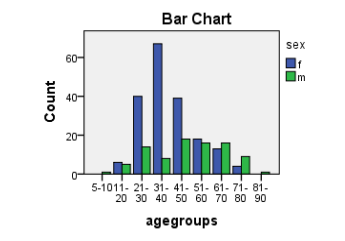Abstract
Background: Hoarseness of voice is a common
symptom presentation in the Department of ENT.
The etiology ranges from benign to malignant
causes. Video nasopharyngolaryngoscopy is an
effective method of evaluation of the laryngeal
pathologies. The aim of the study was to study the
different etiological factors of hoarseness of voice
presenting in the Department of ENT at Western
Regional Hospital, Pokhara.
Materials and Methods: A retrospective
observational longitudinal study was done in the
Department of ENT, Western Regional Hospital
after approval from IRC, Pokhara Academy of
Health Science. A total of 275 patients presenting
to the ENT Department with hoarseness of more
than two weeks duration were examined with video
nasopharyngolaryngoscopy (NPL) from April 2018
to March 2019. The data were electronically entered
and analyzed with SPSS Version 21.
Results: Total number of cases were 275 among
which 187 (68%) were females whereas 88 (32%)
were males. Vocal cord nodules were observed in
107 patients (38.9%), features of laryngopharyngeal
reflux were observed in 54 patients (19.6%)
muscle tension dysphonia was seen in 49 (17.8 %
), vocal cord polyp in 6 patients (2.2%), left vocal
cord palsy in 7 patients ( 2.5%), right sided vocal
cord palsy in 2 patients (0.7%). The hemorrhagic
polyp, leucoplakia and ventricular dysphonia were
observed in 3 patients each.
Conclusion: Since causes of hoarseness of voice
range from simple benign diseases to malignant
diseases, it is mandatory to evaluate every cases
of hoarseness of voice replace with of more than
2 weeks duration with history, videolaryngoscopic
examination and investigations.
References
Comprehensive Analysis of Benign Vocal Fold
Lesions Causing Hoarseness of Voice and Our
Experience with Cold Knife Endolaryngeal Surgery
in a Tertiary Healthcare Centre. Indian J Otolaryngol
Head Neck Surg. 2019 Oct;71(S1):515–21.
2. Parikh NP. Aetiological study of 100 cases
of hoarseness of voice. Indian Journal of
Otolaryngology. 1991 Jun 1;43(2):71-3.
3. Vindrani N, ENT, Patel M, ENT, Gaur S, ENT,
et al. Role of videolaryngoscopy in patients with
hoarseness of voice. Santosh Univ J Health Sci.
2020 Jan 28;5(2):109–12.
4. Keesecker SE, Murry T, Sulica L. Patterns in
the evaluation of hoarseness: Time to presentation,
laryngeal visualization, and diagnostic accuracy:
Patterns in the Evaluation of Hoarseness. The
Laryngoscope. 2015 Mar;125(3):667–73.
5. Soni S, Chouksey S. A Study of
Clinicopathological Profile of Patients of
Hoarseness of Voice Presenting to Tertiary Care
hospital. Indian J Otolaryngol Head Neck Surg.
2017 Jun;69(2):244–7.
6. Van Houtte E, Van Lierde K, D’Haeseleer E,
Claeys S. The prevalence of laryngeal pathology
in a treatment-seeking population with dysphonia:
Prevalence of Laryngeal Pathology. The
Laryngoscope. 2010 Feb;120(2):306–12.
7. 7. Shrestha BL, Amatya RC, Sekhar KC,
Shrestha I, Pokharel M. Aetiological factors of
hoarseness in patients attending at Kathmandu
University Hospital. Bangladesh Journal of
Otorhinolaryngology. 2013 May 3;19(1):14-7.
8. Baitha S, Raizada RM, Singh AK, Puttewar MP,
Chaturvedi VN. Clinical profile of hoarseness of
voice. Indian journal of otolaryngology and head
and neck surgery. 2002 Jan 1;54(1):14-8.
9. Taous A, Hossain SMR, Rahman MM.
Aetiological factors of hoarseness of voice in patients
attending in a district level hospital. Bangladesh J
Otorhinolaryngol. 2019 Dec 19;24(2):125–30.
10.. Kataria G, Saxena A, Singh B, Bhagat S, Singh
R. Hoarseness of voice: Etiological spectrum.
Online Journal of Otolaryngology. 2015 Jan 2;5.
11. Dymek A, Dymek L, Starczewska-Dymek L,
Bożek A, Dymek T, Nowak K. [Laryngopharyngeal
Reflux (LPR) in patients with persistent
hoarseness]. Otolaryngol Pol Pol Otolaryngol. 2012
Feb;66(1):33–8.

